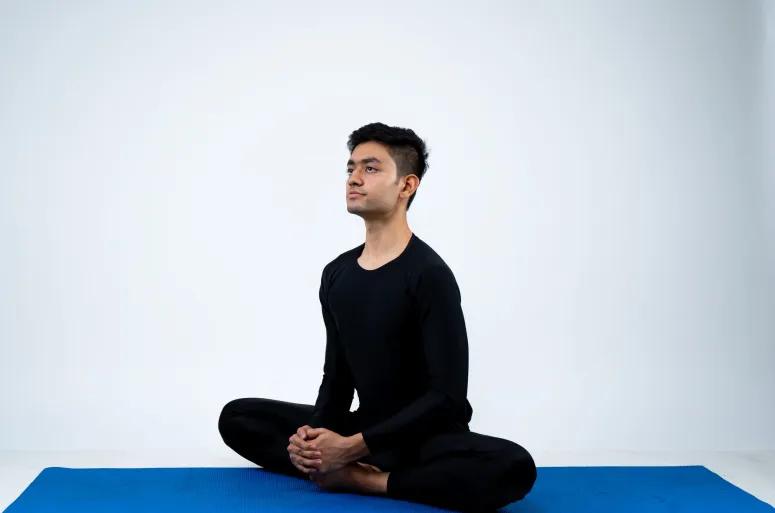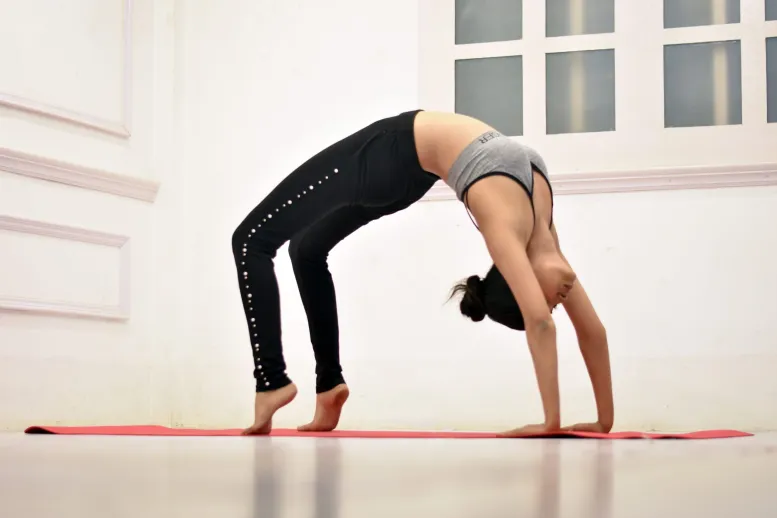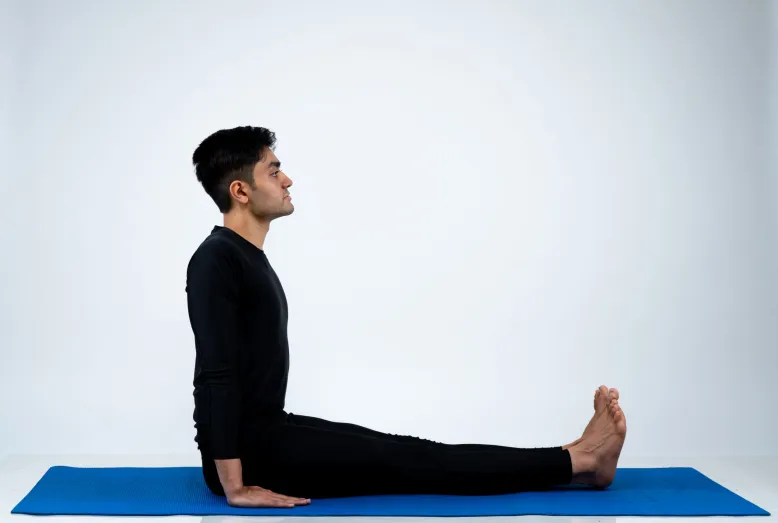Baddha Konasana, also known as Bound Angle Pose, Butterfly Pose, or Cobbler’s Pose, is a basic asana (yoga pose) included in both hatha and contemporary yoga practices.
Baddha Konasana, often regarded as a peaceful and approachable position, provides several benefits that go well beyond its deceptively basic look. This tutorial dives into the different facets of Baddha Konasana, including its history, technique, variations, benefits, and warnings.
Understanding Baddha Konasana
Baddha Konasana, derived from Sanskrit, translates to the Bound Angle Pose (“Baddha” meaning bound, “Kona” meaning angle, and “Asana” meaning pose). This asana is also affectionately termed the Butterfly Pose due to the fluttering motion of the legs during the practice and is sometimes referred to as the Cobbler’s Pose, mirroring the sitting position of cobblers at work.
Benefits of Baddha Konasana:
- Improves Flexibility: Regular practice of Baddha Konasana gently stretches the muscles of the inner thighs, groins, and hips, increasing flexibility in these sometimes stiff and neglected areas. This can be especially advantageous for athletes or those who lead sedentary lifestyles.
- Stimulates Abdominal Organs: Deepening the forward-bending movement massages and stimulates the abdominal organs. This stimulation improves digestion and relieves stomach pain.
- Baddha Konasana promotes pelvic health by expanding the hips and extending the muscles that surround the pelvis. It is especially advised for prenatal and postnatal yoga, which can help with a smoother pregnancy and recovery, but only with adaptations and expert direction.
- Reduces Stress and Anxiety: Baddha Konasana, like many sitting forward bends and hip openers in yoga, relaxes the mind. It can help reduce stress, anxiety, and moderate depression by instilling a sense of security and stability.
- Improved Circulation: This position promotes blood circulation throughout the body. Improved circulation ensures that the body’s tissues receive enough oxygen and nutrients, improving general health.
- Therapeutic for Flat Feet: The alignment of the feet in Baddha Konasana strengthens the foot muscles, which may provide relief for flat feet and other related discomforts.
Practice and modifications
To reap the full benefits of Baddha Konasana, proper alignment, and focused practice are essential. Here’s a step-by-step tutorial for getting into the pose:
- Sit with your spine straight and your legs out in front of you.
- Bend your knees and move your heels towards your pelvis. Drop your knees to the sides and push the soles of your feet together.
- Clasp your feet or ankles with your hands, keeping your spine straight. Avoid hunching forward and instead stretch from the base of your spine.
- Maintain the position while taking deep, steady breaths. To get a deeper stretch, softly press your knees down with your elbows or lean forward from the hips.
Modifications and props, like cushions or blocks, can help novices and individuals with limited flexibility maintain their posture.
For example, sitting on a cushion can raise the hips, making it simpler to maintain an upright posture. Alternatively, putting blocks beneath the knees helps relieve pressure in the hips and groin.
Cautions and Contraindications
While Baddha Konasana is typically safe, anyone with certain health issues should exercise caution or seek medical guidance before adopting it into their regimen. Those with knee or hip ailments should avoid or modify their stance to avoid exacerbating their symptoms. Additionally, anyone suffering from sciatica should proceed with caution, since the position may increase symptoms.
Beyond Pose: A Holistic View
In yoga, physical practice (asana) is only one component of a larger philosophical system aiming at establishing harmony between body, mind, and spirit. This comprehensive approach is exemplified by Baddha Konasana, which provides both physical and emotional advantages. It teaches tolerance and acceptance by encouraging practitioners to gradually test their boundaries while remaining mindful of their bodies’s restrictions.
Final Thoughts
With its basic beauty, Baddha Konasana serves as a bridge to learning yoga’s deeper core. It serves as a reminder that vulnerability is strength, flexibility is surrender, and progress is patience. As you incorporate this posture into your practice, may you discover not just a physical stretch and strength but also a moment of quiet, a breath of tranquility, and a step closer to the harmony that yoga offers.
Whether you’re a seasoned yogi or new to the practice, Baddha Konasana asks you to go into the depths of your physical and mental environment, demonstrating that sometimes the most profound journeys begin sitting, feet joined together, ready to unfold.
What are the benefits of Baddha Konasana?
Baddha Konasana: Benefits for Physical and Mental Health
• Improves Flexibility: Stretches inner thighs, groins, and muscles around the hips, enhancing flexibility.
• Stimulates Abdominal Organs: Correctly bending the pose stimulates abdominal organs, improving digestive system functioning.
• Enhances Pelvic Circulation: Increases blood circulation in the pelvic region, beneficial for reproductive and urinary health.
• Strengthens Spine: Maintains an erect spine during the pose, relieving back pain and promoting better posture.
• Reduces Stress and Anxiety: Calms the mind, reducing stress and anxiety levels.
• Therapeutic for Flat Feet: Strengthens feet and arches muscles, relieving flat feet.
• Promotes Inner Peace: Focuses on breath and maintains pose, promoting tranquility.
• Aids in Sciatica Relief: Gentle stretching of legs and hips reduces pressure on the sciatic nerve.
• Improves Body Awareness: Encourages tuning into body signals and respecting limits.
• Fosters Emotional Balance: Calms mind, aiding in managing mood swings and coping with emotional stress.
Which chakra is activated by Baddha Konasana?
Baddha Konasana, or Bound Angle Pose, activates the Svadhisthana Chakra, or Sacral Chakra, in the lower abdomen. This chakra is associated with creativity, emotional balance, sexuality, and pleasure. Activating promotes emotional release, harmony, and well-being, enhancing openness, fluidity, and connection to others. Balancing this chakra can lead to increased emotional awareness and creativity.
Can we do a butterfly pose on the bed?
Butterfly Pose on a Bed: A Guide
• Support Your Back: Sit comfortably on the bed with your back supported by pillows or against the headboard.
• Use Props: Place cushions or blankets under your hips to elevate them slightly.
• Adjust Your Position: Adjust the distance between your heels and pelvis based on your comfort level and flexibility.
• Relax and Breathe: Take slow, deep breaths to deepen the stretch gradually over time.
• Cultivate Mindful Awareness: Observe any sensations or areas of tension and adjust the position or intensity of the stretch accordingly.
• Stay Gentle: Be gentle with yourself and avoid forcing or straining in the pose.
• This pose can be a restorative practice before bedtime or upon waking up.
Can I do Baddha Konasana during periods?
Baddha Konasana Benefits during Menstruation
• Relieves Cramps: The pose’s gentle stretching of the inner thighs and groins eases menstrual cramps.
• Promotes Relaxation: The pose’s calming effect on the mind and body promotes well-being and relaxation.
• Improves Circulation: The pose improves circulation to the pelvic region, alleviating some menstruation symptoms.
• Adaptable: Modifications can be made to suit low energy levels by supporting knees with cushions or blocks or leaning back against a wall.
• Fosters a Sense of Grounding: The pose aids in grounding and centering practices, comforting during menstruation.
• Consultation with a healthcare provider or a qualified yoga instructor is advised for specific concerns regarding yoga practices during menstruation.





No Comments